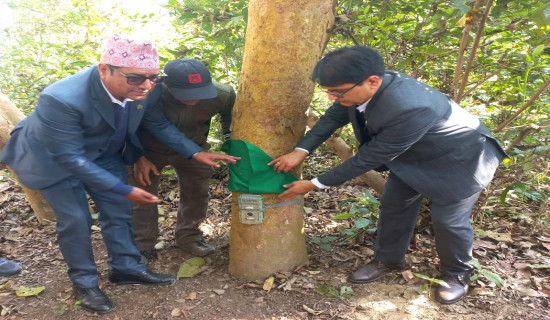- Tuesday, 16 December 2025
Snowmelt Concerns
Humans rely on nature for survival and livelihood. Forests, plants, snow, rivers, rain, sun, air and soil are sources of life. These elements of nature have made the earth a liveable place. If any of them decline or ceases to exist, the life of humans, animals and other species becomes difficult. Balance in nature is vital for the sustenance of creatures. If it gets imbalanced, humans’ existence comes under a threat. Today, global warming caused by greenhouse gas emissions, has started to endanger the life on Earth. Human activities are largely responsible for the worsening of the environment. Scientists and experts are scratching their heads to grasp the phenomenon of global warming and have come up with disturbing findings about the climate change and its devastating consequences on people.
These days the people living across different climatic zones are experiencing the effect of rising temperatures. The Kathmandu Valley, known for its mild climate, is witnessing unusual heat and humidity in the atmosphere. As the monsoon rains have not come in their full scale, the crowded urban areas appear like hot oven, with the denizens resorting to various means to beat the heat. This abnormal condition has become a norm, rather than an exception, thanks to the greenhouse gas emissions that are amplifying the earth's temperature. Nepal's snowy peaks are disproportionately hit by the global warming, imperilling the livelihoods of the communities living in the mountainous region and beyond.
According to a news report published in this daily on Sunday, snow and ice are melting at an alarming rate in the Himalayas. Since the late 1990s, the thinning rate of glacier on Lubuche Peak and Island Peak near Mount Everest has reached two metres per year. The fast melting has laid bare the black rocks which absorb heat faster. Scientists have warned that this glacier could vanish by the mid-century, if the current rate of melting continues. A study has revealed that mountain glaciers are losing snow volume globally. However, experts have yet to gather adequate information on their upper reaches above 5,000 metres. Snow levels are almost 20 per cent below normal this year. Decreasing levels of ice and snow have affected farming, tourism, hydropower development and transportation, among others.
Mountain farmers are discouraged from growing seasonal crops in the absence of adequate snowfalls. The locals have been forced to shift to those crops grown in hot climate. Similarly, snow-melting also causes rock falls that hamper movements on the road and damage the bridges and other vital infrastructures. Avalanches and landslides block river channels, generating the fear of floods in the downstream communities. It is obvious that tourists will not visit to watch the black rock mountains that get exposed following the incessant snow-melting and glacier loss. The climbers camping at the Mt. Everest base camp have felt weather variations in the past few years. They experienced heat in the camps and unexpected cold at the peak.
Experts have suggested planting native tree species that enable the ground surface to keep more snow and regulate flows in the rivers. Another way to tackle the problems arising from snowmelt is to improve the water storage capacity and distribution systems. The local people need to be better informed about the weather condition through weather forecasting and early warning system so that they can properly plan safety and work schedule. Global warming is a problem faced by the entire world but the developed and industrialised nations have larger share in emissions of greenhouse gases. So they must play leading role both in mitigation and adaptation fronts.
















